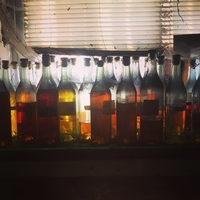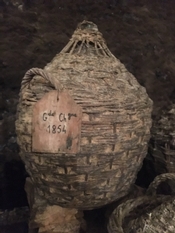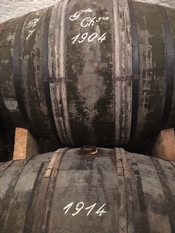Harvest is a remarkable time to visit Cognac as it truly brings everything back to the basics. Without a great harvest there is no great wine. Without great wine you really can’t begin to make a great eau de vie (the distillate before it’s aged in barrel to become Cognac). And without a great eau de vie, you can’t have a great Cognac. Harvest in Cognac reminded me of one crucial thing:  Cognac is an agricultural product. And it depends greatly on the handiwork of those who are daily working in the vineyards throughout the year.
Cognac is an agricultural product. And it depends greatly on the handiwork of those who are daily working in the vineyards throughout the year.
This is not to discount the fact that much of the finished product relies on the aging process, and blending expertise from producer to producer. Indeed, through the myriad visits we made to each house in the region, it seems each makes a concerted effort to set their Cognac apart. At Cognac Frapin, the producer depends on both wet and dry cellars to age their eau de vie, taking advantage of how the different conditions impart different characteristics on the finished spirit. (Cognac aged in Dry cellars are thought to be elegant and refined, losing 5% annually to the evaporated "Angel’s Share," while wet cellars develop suppleness and roundness to the spirit, losing about 3% annually to the Angel’s Share.)
Pierre Ferrand is one of the few houses that continues to use higher percentages of Colombard for their base wine to hold true to the region’s heritage.
Hardy uses special methods to age water with small percentages of eau de vie in barrel before marrying it into the spirit for aging in neutral barrels and later  blending. The resulting Cognacs reveal smooth, fruity characters that linger into a soft, floral finish.
blending. The resulting Cognacs reveal smooth, fruity characters that linger into a soft, floral finish.
Hine is the only producer extended the right to produce “Early Landed” cognacs, which allows them to ship single vintage barrels to the United Kingdom to be aged in cask on British soil, a centuries-old tradition. These casks are then shipped back to Cognac to be bottled with a distinctive “Early Landed” label.
Newer producer, Bourgoin, has been a grape grower in the region for generations and have recently launched their own cognac brand with truly “craft” approach in both principle and finished product. No blending, no filtering, no added sugar, no added color, Bourgoin aims to be a true vineyard-to-glass representation of terroir and heritage.
But what happens when your entire workforce has vanished? What happens when the experts who lovingly tend the vineyards have been requisitioned to another part of the country altogether? This was the case for Cognac during the years of 1914-1918 for the generation fighting in the Great War, or World War I.
Within those four years, France mobilized 8 million men, including 3.7 million right at the start in August 1914–just before harvest. This represented 60 percent of the active male population, of which almost half were assigned to combat units at the front. The first effort of mobilization for working women were specifically related to agriculture. On August 7, 1914, René Viviani, the acting Prime Minister of France, addressed women throughout the country asking them to complete the harvest for the fall and to manage preparations for crops in the following year. Altogether, along with the help of children, teenage girls under 20, and aged parents, 3.2 million female agricultural women took over from the duties for the 3 million farmers who were called into combat between 1914 and 1918. It’s worth noting that much of their work  was put at a greater disadvantage due to the fact that their draught animals had all been requisitioned by the army.
was put at a greater disadvantage due to the fact that their draught animals had all been requisitioned by the army.
With the men fighting at the front, the destiny of the harvest lay in the hands of women who gathered together to maintain the vineyards, manage the harvest, and produce the wine and eau de vie. The 1914 harvest, which has been documented as being particularly exceptional, has reverently become known as the ‘Ladies Vintage.’
Almost all of the houses I visited graciously offered a tour of their “paradise cellar,” where producers keep their oldest production in neutral barrels and large, glass demijohns. Many of these barrels are more than a century old and still finish many of the producers’ Cognacs today. I glimpsed vintages from 1840, 1854, 1870, 1893, and 1904. But I remember feeling a particular pang of emotion when visiting the paradise cellars of Courvoisier, Hine, and Hardy and seeing the greying, dusty barrels marked in chalk with the year 1914. Each house specifically pointed out their prized barrels of the “Ladies Vintage.”
At Hardy in particular, I was uniquely moved. It was led by Bénédicte Hardy, a fifth generation Cognac producer who may be one of the most delightful women I’ve ever met. Guiding our time together with a distinctive style and class, Hardy falls somewhere between Catherine Deneuve and Queen Elizabeth. (Let’s just call her la Reine de Cognac.)
Perhaps it was a specific warmth in Hardy’s regal demeanor, that I felt drawn to. It was as if there was a deeper connection she felt to the barrel–not surprising considering there were those in her near immediate family who would have been directly involved with its production.
Although I’ve been fortunate to find myself in situations where I’ve been able to taste wines and spirits of significant age, something in particular about this Ladies Vintage felt strikingly special. It’s not the sort of thing you can just passively sip and add to your personal list of the aged vintages you’ve tasted; like a rare bird on a birder’s “life list.”
When Hardy carefully summoned the wine thief from the barrel and released about an ounce of it into my glass, my eyes became transfixed. To taste a Cognac like this is really beyond palate comprehension. It’s like being invited to a time and place to which you are quite literally a foreigner. Though I caught notes of candied orange peel, mushroom, and smoked honey, the experience frankly, defies taste descriptors.
It’s strange and somewhat bewitching that the sense of taste is really the only of our five senses that can directly connect us with the past; in this case with the members of that “Lost Generation,” and the family members who rose to the occasion to carry on with the daily responsibilities of life.
As my week in Cognac drew to a close, I couldn’t help but feel I’d witnessed something much more than a snapshot of a wine region. Sure, it was tremendously insightful to see the soil differences between Grande Champagne and Petite Champagne, walk the vineyards as the mammoth mechanical harvesters were shaking the grapes from their canes, and learn first-hand how to make the local Cognac-spiked coffee cocktail, brulot, long supped by farmers mid-morning during harvest for added sustenance. But seeing the great respect producers had for the Ladies Vintage, and having the opportunity to taste from the vintage myself was both eye-opening and humbling. Perhaps I’ll have other opportunities to taste older vintages of wines or spirits in the future, but I doubt I’ll sample another one without first considering the time and place from which it came.
Side Note: It’s important to note that many parts of France experienced this same challenge, and not just with an impact on wine, but all agriculture. Champagne in particular was hard hit. While many associate the Battle of the Marne with World War I, we tend to forget that an early, major, week-long battle was waged in the heart of Champagne in 1914. (A second took place four years later.) During the First Battle of the Marne, 80,000 French soldiers died between September 5-12. The Germans lost 68,000 and the British 13,000.
But following the battle, the territory was ensconced in a seemingly endless and tumultuous period of trench warfare, which reduced much of the region to rubble. Yet, many houses continued to make Champagne utilizing the cellars and crayères (often more than 80 feet beneath street level) deep beneath the city to produce wine and conduct business.
Later that September, there are numerous accounts of children volunteering to bring in the harvest by sneaking their way through the vines undetected by enemy fire. But the effort was met with the tragic death of more than 20 children who had been killed by sniper fire and indiscriminate shelling. Indeed, it’s important to remember that vintages from these war-torn periods of history are treasures that may have endured the test of time, but not without a significant amount of loss.
Connect with her on Twitter: JessicaNDupuy
